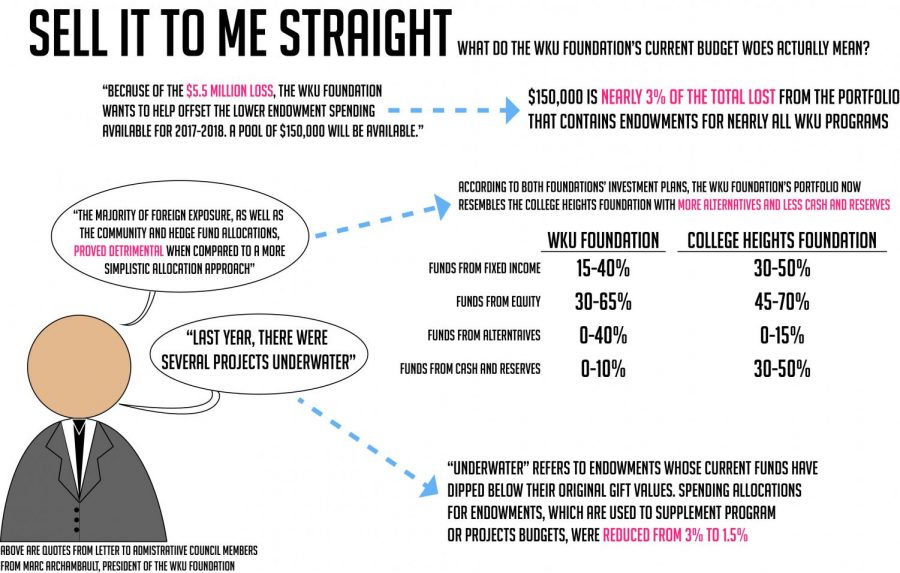12 WKU endowments reach ‘underwater’ level
March 31, 2016
The WKU Foundation will adjust the investment of the endowments and funds it manages and will continue its policy to reduce spending in troubled endowments after reporting a $5.5 million loss for last fiscal year.
The foundation, which invests gifts given to WKU, had previously projected a positive annual return of 7.3 percent over 10 years with a risk of 13.1 percent, according to a letter released by the president of the foundation, Marc Archambault. The 2015 fiscal year ended with a 6.83 percent loss.
In the letter to WKU Administrative Council members, Archambault said that the loss in investment had brought some funds below their original endowment.
“Last year, there were several projects [endowments] underwater, which is when the principal is less than the historical gift value,” Archambault said.
Archambault was asked for comment but did not respond at the time of publication.
Paula Jarboe, chief financial officer and treasurer for the WKU Foundation, verified how many of the 220 endowments the foundation manages that were underwater and some perspective on how gifts are managed.
“As of our audit on 12/31/15, we reported 12 underwater endowments,” Jarboe said in an email. “If a gift is made when the market is at a peak, it has a greater potential to experience a down market.”
Jarboe said that although the outcome is disappointing, other universities are seeing similar trends.
“The Investment Committee and the Board are obviously disappointed with the return results,” Jarboe said. “However, most individuals and organizations are experiencing a similar situation in the current market.”
In his letter, Archambault mentioned that the University of Louisville had posted a $66.2 million loss since the beginning of fiscal year 2015, equating to a negative return of 8.3 percent. This may seem like a massive loss compared to WKU’s $5.5 million loss because of the size of U of L’s portfolio. There is only a 1.47 percentage-point difference in the loss in investment of both universities.
David Dubofsky, a finance professor at the University of Louisville, had an opinion on why his university hemorrhaged money in the last investment year.
“We had an [8.3] percent loss because we didn’t properly diversify,” Dubofsky said. “If you lose [8.3] percent, you are taking unnecessary risk and whoever is responsible should probably be fired.”
Dubofsky blamed the losses that university foundations are experiencing on risky hedge funds and commodities that left endowments overexposed.
“I couldn’t argue with putting five percent of a portfolio in well managed hedge funds but you have to diversify,” Dubosky said. “It’s fine for a small portion … but you can’t put that much of your portfolio in risky investments.”
Archambault mentioned similar investment choices as being the majority of the problem with last investment year’s results.
“Though the exposure to diversifying asset classes such as REITs and foreign unhedged bonds helped in 2014, the majority of foreign exposure, as well as the commodity and hedge fund allocations, proved detrimental when compared to a more simplistic allocation approach,” Archambault wrote.
Jarboe said that the WKU Foundation has utilized these alternative strategies in investment since 2007.
According to an email from Jarboe, the foundation had invested $68,904,075 of endowments at the end of 2015.
Donald Smith, president of the College Heights Foundation, which manages and invests WKU’s scholarship funds, explained his view on the role of foundations.
“We don’t just want to be wealth preservationists,” Smith said. “We have to grow incrementally to fight inflation and meet expectations.”
Smith said that not only did foundations have to make sure that their endowments are around for years to come, but they also have to expand in order to cover spending percentages and to provide more support in the future.
“Conservative is a relative word,” Smith said. “Every investment fund has to find the horizon in order to beat inflation. If you can’t grow by at least four percent, then you lose.”
The WKU Foundation has now adjusted its investments to have 25 percent less risk with more stabilized growth, according to the letter from Archambault and the foundation’s current investing policy.
New target projections from the foundation predict a 6.75 percent return next year with a 10.3 percent expected annual risk.
While Dubofsky said that these projections seem like average expectations, he warned that risk estimations can’t predict recovery.
“Projections are just that; projections,” Dubofsky said. “Keep in mind, you’re dealing with the future and you don’t know what the market will be.”













